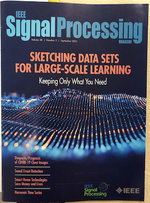2
ADMM-inspired image reconstruction for terahertz off-axis digital holography
Abstract: Image reconstruction in off-axis terahertz digital holography is complicated due to the harsh recording conditions and the non-convexity form of the problem. In this paper, we propose an inverse problem-based reconstruction technique that jointly reconstructs the object field and the amplitude of the reference field.
Learning to Reconstruct Signals From Binary Measurements
Abstract: Recent advances in unsupervised learning have highlighted the possibility of learning to reconstruct signals from noisy and incomplete linear measurements alone. These methods play a key role in medical and scientific imaging and sensing, where ground truth data is often scarce or difficult to obtain.
Interferometric lensless imaging: rank-one projections of image frequencies with speckle illuminations
Abstract: Lensless illumination single-pixel imaging with a multicore fiber (MCF) is a computational imaging technique that enables potential endoscopic observations of biological samples at cellular scale. In this work, we show that this technique is tantamount to collecting multiple symmetric rank-one projections (SROP) of an interferometric matrix–a matrix encoding the spectral content of the sample image.
The Separation Capacity of Random Neural Networks
Abstract: Neural networks with random weights appear in a variety of machine learning applications, most prominently as the initialization of many deep learning algorithms and as a computationally cheap alternative to fully learned neural networks.
Asymmetric compressive learning guarantees with applications to quantized sketches
Abstract: The compressive learning framework reduces the computational cost of training on large-scale datasets. In a sketching phase, the data is first compressed to a lightweight sketch vector, obtained by mapping the data samples through a well-chosen feature map, and averaging those contributions.
Sketching Datasets for Large-Scale Learning
(for a longer and free version on arXiv see here)
Abstract: This article considers “compressive learning,” an approach to large-scale machine learning where datasets are massively compressed before learning (e.g., clustering, classification, or regression) is performed.
Breaking the waves: asymmetric random periodic features for low-bitrate kernel machines
Abstract: Many signal processing and machine learning applications are built from evaluating a kernel on pairs of signals, e.g. to assess the similarity of an incoming query to a database of known signals.
Compressive Imaging Through Optical Fiber with Partial Speckle Scanning
Abstract: The lensless endoscope (LE) is a promising device to acquire in vivo images at a cellular scale. The tiny size of the probe enables a deep exploration of the tissues.
Compressive learning with privacy guarantees
Abstract: This work addresses the problem of learning from large collections of data with privacy guarantees. The compressive learning framework proposes to deal with the large scale of datasets by compressing them into a single vector of generalized random moments, called a sketch vector, from which the learning task is then performed.
MAYONNAISE: a morphological components analysis pipeline for circumstellar discs and exoplanets imaging in the near-infrared
Abstract: Imaging circumstellar discs in the near-infrared provides unprecedented information about the formation and evolution of planetary systems. However, current post-processing techniques for high-contrast imaging using ground-based telescopes have a limited sensitivity to extended signals and their morphology is often plagued with strong morphological distortions.
